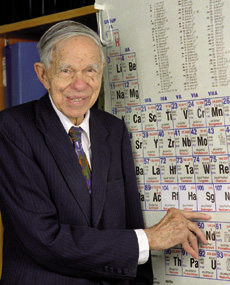 |
|
|
 |
Glenn Theodore Seaborg had an unorthodox and unpopular theory. In 1944 he conceptualized a radical way to fit the hypothetical and yet undiscovered transuranium elements into the periodic table.
Called the "actinide concept" of heavy element electronic structure, it predicted that the heaviest naturally occurring elements, together with the synthetic transuranium elements, would form a transition series of "actinides," analogous to the rare-earth series of "lanthanides." It also called for a total overhaul of the periodic table, which hadn't seen major change since Mendeleev first designed it in the 19th century. Seaborg's peers exhorted him that pushing this radical idea would be professional suicide. But, as he was to reflect later, "Fortunately for me, at the time my scientific reputation was nothing to worry about losing. And even more fortunate, I was right."
Right he was. In return for his daring, Glenn Seaborg was awarded the 1951 Nobel Prize in chemistry, which he shared with his colleague Edwin McMillan "for their discoveries in the chemistry of the transuranium elements." At 39 years old, he was one of the youngest winners ever of the most highly coveted academic prize in the world. To Glenn Seaborg, discovery was a way of life. By the time he accepted the Nobel Prize he had successfully synthesized eight of the transuranium elements he predicted.
Seaborg went on to win countless honors in his career, yet he may have received the most attention for identifying plutonium in 1941. The discovery catapulted him into the Manhattan Project to work on a mission seemingly impossible -isolate enough plutonium, an element just synthesized in infinitesimal quantities, to build a bomb massive enough to end World War II. Working at the University of Chicago, Seaborg led a team of more than 100 scientists into developing a successful means of separating fissionable plutonium. Within six months a sufficient quantity of Pu-239 had been produced to create the bomb that would later be used with devastating results on the Japanese city of Nagasaki. Five days later World War II would be over.
Despite his belief that the creation of the bomb was a necessity to keep Nazi Germany from developing it first, Seaborg had ardently opposed using the bomb on civilian targets, and was for the rest of his life a forceful proponent of nuclear disarmament.
In 1961 he took his high profile
as a Nobel Prize winner to Washington where he could take action on the issues he passionately believed in. As an advocate of nuclear disarmament, he fought to regulate the uses of atomic energy as weapons. He headed President Kennedy's Atomic Energy Commission, helping to win a victory in the signing of the Limited Test Ban Treaty in 1963, and later the Non-Proliferation Treaty to limit the spread of nuclear weapons. An environmentalist, he advocated conservation of natural resources, and saw nuclear power as the future of energy. When appointed to Reagan's National Commission on Excellence in Education, he pushed hard for more aggressive funding and higher standards in schools, and published his landmark report,
"A Nation at Risk." In all he had advised ten presidents,
from Roosevelt to Bush, on matters of science and state, always returning to Berkeley to his truest calling, his research and his teaching.
 |
|
|
 |
Over the years Seaborg and his team discovered a total of ten elements. When element 106 was officially named seaborgium in 1997, Glenn called it the greatest honor of his lifetime. He remained a beloved chemistry professor at UC Berkeley for nearly 60 years, popular with students of every age for his willingness to sit and talk, or to autograph a periodic table.
Associate director at large of the Lawrence Berkeley National Laboratory and chairman of the Lawrence Hall of Science, Seaborg constantly traveled the world participating in meetings and lectures, and he never stopped working for long-term solutions to the problems of arms control, education and
energy. When writing his memoirs, he reflected, "My research still calls, but I've felt a growing urge to take the time to share the lessons of my experience." Indeed, Glenn Seaborg has taught us through his groundbreaking research, political commitment and brilliant example of a life lived to its fullest. end
|

